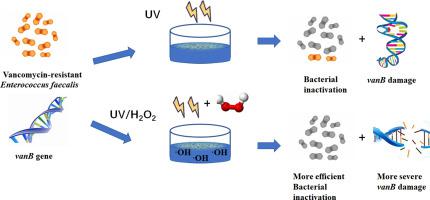Journal of Water Process Engineering ( IF 6.3 ) Pub Date : 2022-07-31 , DOI: 10.1016/j.jwpe.2022.103004 Rui Gao , Miao Yu , Jingni Xie , Minghao Sui

|
The proliferation of antibiotic resistance in water environment which may cause antibiotic therapy failure has attracted worldwide attention. However, the effects of UV-based advanced oxidation processes on inactivation of antibiotic resistant bacteria (ARB) and degradation of antibiotic resistance genes (ARGs) have not been well studied. This study aimed to comparatively investigate the removal efficacy in inactivating the vancomycin-resistant Enterococcus faecalis (VRE) and degrading its containing vanB gene under exposure to UV and UV/H2O2. The results showed that VRE was readily inactivated in both UV and UV/H2O2 processes. Although UV/H2O2 was only slightly superior to UV alone in VRE inactivation, it significantly inhibited the bacterial photoactivation and regrowth. UV/H2O2 indeed achieved synergistic degradation of intracellular vanB (0.1–0.8 log), which could be further enhanced by increasing the UV intensity, lowering pH and adding H2O2 in batches. The enhanced induction of  OH resulted in the cell membrane damage, facilitating the entrance of excess
OH resulted in the cell membrane damage, facilitating the entrance of excess  OH and more efficiently oxidizing the released intracellular ARGs. Overall, the presence of humic acid inhibited the inactivation of VRE and degradation of vanB, while lower concentrations of humic acid (2.5–5 mg/L) could act as free radical initiator and slightly promoted vanB degradation in UV/H2O2 process. Our findings suggested that UV/H2O2 has more advantages on the control of ARB and intracellular ARGs compared to UV alone.
OH and more efficiently oxidizing the released intracellular ARGs. Overall, the presence of humic acid inhibited the inactivation of VRE and degradation of vanB, while lower concentrations of humic acid (2.5–5 mg/L) could act as free radical initiator and slightly promoted vanB degradation in UV/H2O2 process. Our findings suggested that UV/H2O2 has more advantages on the control of ARB and intracellular ARGs compared to UV alone.
中文翻译:

UV和UV/H2O2照射下耐万古霉素粪肠球菌失活及胞内vanB基因降解
水环境中抗生素耐药性的扩散可能导致抗生素治疗失败已引起全世界的关注。然而,基于紫外线的高级氧化过程对抗生素抗性细菌 (ARB) 失活和抗生素抗性基因 (ARGs) 降解的影响尚未得到很好的研究。本研究旨在比较研究在UV和UV/H 2 O 2照射下灭活耐万古霉素粪肠球菌(VRE)和降解其含有的vanB基因的去除效果。结果表明,VRE 在 UV 和 UV/H 2 O 2工艺中都容易失活。虽然 UV/H 2 O 2在 VRE 失活方面仅略优于单独的紫外线,它显着抑制了细菌的光活化和再生。UV/H 2 O 2确实实现了细胞内vanB的协同降解(0.1-0.8 log),这可以通过增加UV强度、降低pH值和分批添加H 2 O 2来进一步增强。OH的增强诱导 导致细胞膜损伤,促进过量
导致细胞膜损伤,促进过量 OH 的进入并更有效地氧化释放的细胞内 ARGs。总体而言,腐植酸的存在抑制了 VRE 的失活和vanB的降解, 而较低浓度的腐植酸 (2.5–5 mg/L) 可以作为自由基引发剂并略微促进UV/H 2 O 2过程中的vanB降解。我们的研究结果表明,与单独的 UV 相比,UV/H 2 O 2在控制 ARB 和细胞内 ARGs 方面具有更多优势。
OH 的进入并更有效地氧化释放的细胞内 ARGs。总体而言,腐植酸的存在抑制了 VRE 的失活和vanB的降解, 而较低浓度的腐植酸 (2.5–5 mg/L) 可以作为自由基引发剂并略微促进UV/H 2 O 2过程中的vanB降解。我们的研究结果表明,与单独的 UV 相比,UV/H 2 O 2在控制 ARB 和细胞内 ARGs 方面具有更多优势。











































 京公网安备 11010802027423号
京公网安备 11010802027423号